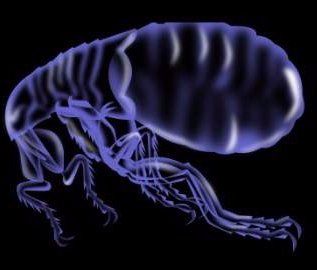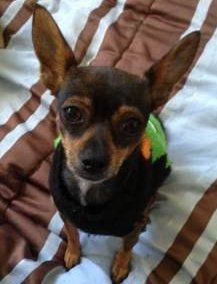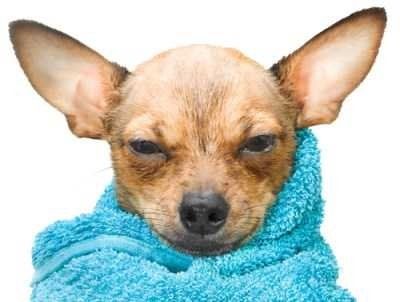Chihuahua Skin Care
Overview
It is not uncommon for a Chihuahua puppy or dog to have a skin problem; this it can be frustrating for owners to figure out the cause and treatment (sometimes even with the help of a vet). There are many different skin issues that can affect this breed and therefore treatment - and future prevention- will vary.
This section will discuss:
- Signs and symptoms that a Chihuahua is indeed experiencing a skin problem or infection
- The different types of issues that can affect the skin (and coat)- We will discuss common problems and also unusual reactions that can affect the skin that owners may not immediately think of, also touching on curable VS incurable and chronic VS acute.
- Home remedies for Chihuahua skin problems - Easy and relatively inexpensive steps that you can take from home to help treat affected areas - Even if you were told that there is no complete cure
- Times when veterinary intervention will be needed - including tests and procedures that a vet should be performing to diagnose the issue
- Chihuahua skin care tip to keep your Chi's skin healthy - which in turn aids in maintaining a healthy coat

Please note: PetChiDog is reader-supported. Some of the product suggestions on this page are affiliate links. As an Amazon Associate we earn from qualifying purchases. This is at no extra cost to you and helps keep this site running.
Signs and Symptoms of Chihuahua Skin Problems
It's hard to imagine, but there are over 160 different and unique skin problems that dogs can develop. With this said, there are 5 issues that most commonly affect the Chihuahuas breed. You may wonder if your Chi has a problem at all, for example if he/she only randomly scratches or if the coat appears that it may be thinning in a certain area.
Let's look at the top signs and symptoms that there is something wrong with the skin:
Itchy Skin -
Since many - but not all - skin issues - including infection - can cause itching, scratching an itch is the #1 sign. A puppy or dog may not always scratch with his paws, particularly for hard to reach areas. What may a dog do? He may rub an area of his body against a surface, such as a wall or carpeting. He may also nibble at and chew an area
that is causing irritation.
Some dogs have such intense itching, that they will chew an area compulsively until fur is just about gone, causing a bald spot. For Chihuahua who have a skin problem that either developed in the ears or spread to the ears, the dog may shake his head in an effort to find relief.
Dry, Flaky Skin -
For some issues, the skin may be so dry that it flakes off - The flakes may remind you of dandruff. You may not notice this flaking skin until it is time to groom and brush your Chihuahua - and then notice tiny dead skin particles floating in the air that had previously settled into the coat.
Hot Spots - Many have heard this term, but what - exactly - does it mean? A hot spot is an area or areas of very sensitive, irritated skin. The site may be discolored (pink or red). It may also be swollen. For many Chihuahua puppies and dogs, these areas will also be extra sensitive to heat (if you blow dry the coat) and to touch. Lastly, without treatment, hot spot areas of skin may show thinning coat - or bald spots if the issue has been developing and proper treatment has not been given.
A Thinning Coat -
Even without blatant signs of itching, flaking or irritation, if the coat is thinning in some areas or you are noticing this all over the puppy's or dog's full body, this can point to a skin problem - since healthy skin is the foundation for a healthy, thick coat.
Skin Discoloration -
Aside from a pink or red tint to irritated areas, there are some skin problems and infections which may cause the skin to darken or become black.
Scabbing -
The development of scabs is most often the outcome of a dog scratching an itch and creating a wound that then develops a scab in the healing process.
There are other times when a skin condition will cause scab-like lesions on the Chihuahua's body - more will be discussed ahead.
Rash -
A rash may be present with many common Chihuahua skin problems. The rash may be localized to a few areas or it may appear over the entire body (in some cases, it will manifest over the body but stop at the neck and not be present on the dog's face and head).
Rashes do vary in texture; some issues will produce smooth bumps; others will present as a prickly type rash.
Other Accompanying Symptoms -
Along with skin issues, depending on what is ailing the Chihuahua, there may be other issues as well.
This includes weakness, food intolerance, runny eyes, odor coming from the skin itself or from the ears, general discomfort, vomiting and more.
We will look at these in more detail as we continue.
Common Chihuahua Skin Problems
Dry Skin
Without any medical conditions, infection, parasites or other issues, a Chihuahua may simply have a case of dry skin. What makes this happen? Several elements may upset the balance of natural skin oils which can lead to a drying of the skin. Here are the most common reasons:
The weather
- particularly long, cold winters
can cause a drying effect. The combination of cold air outside and heated air inside can - over the course of several months- cause a Chihuahua to have dry skin problems.
Grooming -
In general, a Chihuahua should have a bath every 3 weeks, BUT each puppy and dog's skin and coat will react to that schedule differently.
Too many baths can cause dry skin and for some Chi, having products applied every 3 weeks may just be too much; owners may find that every 4 weeks is what works best as long as the dog's coat holds no true dirt and debris (such as mud in the spring, ice melt chemicals in the winter, etc.), brushings are done on a regular basis and wipes are used on the Chihuahua's face and eye area to remove food debris and any eye discharge.
In addition, regular grooming products used will either help the skin and coat or hurt it. Cheap, improperly balanced products will - over time - cause skin irritation, including dry, itchy skin.
Properly balanced, quality shampoos will work to create healthy skin and coat and importantly, maintain that health.
Bacterial Dermatitis
This will display as circular hair loss patches and the skin that is exposed will erupt and then form scales and crusts. Often, this cannot be treated strictly at home. Once a veterinarian takes cultures and tests the dog for antibiotic sensitivity, the treatment will be a long course of antibiotics (sometimes up to 12 weeks).
The diet is looked over, for any clues to possible food intolerance or food allergy. In addition, many dogs that develop this have a vitamin deficiency. It should be noted that all dogs should receive a daily vitamin and mineral supplement regardless of whether commercial food or home cooked food is given for their main meals.
Yeast Infections on the Skin
All dogs have a tiny amount of yeast on their skin, however when the balance of this is thrown off and there is an overgrowth, it can then become a bothersome infection. It may occur in just some spots (often areas that are warm and moist such as the genital area, neck or ears) or it may be found all over the dog's body.
The signs of this are: itchy skin, red swollen skin, a thinning of the coat and most importantly a terrible odor
that can be compared to a greasy smell. This is your clue that yeast is the culprit.
Medical intervention is needed to kill off this sort of infection. Medicated shampoos, sprays and creams will be prescribed by a veterinarian. In addition, if yeast is found in the ears, the vet may rinse the ears in his office and then make sure that owners follow up at home with routine cleansing of the ears with a medicated solution.
Sebaceous Adenitis (SA)
This type of skin disorder usually does not affect older dogs; it is most commonly seen with puppies and adolescents. This is a perplexing skin disorder in which antibodies attack and destroy a dog's skin glands. In severe cases, the glands are permanently damaged.
The cause of this skin problem is unknown, although there are some skin care tips and home remedies which can help.
Here are the telling signs of SA:
- Hair loss - sometimes in circular patterns
- The coat may become matted in some areas
- Casts will form around hair shafts
- There will be a strong, intense itching
- White/silver color scales will appear on the dog's skin - in some cases there will be quite a bit of scaling.
- There will be an odor that could be compared to a musty smell
This will be diagnosed by skin biopsy. In severe cases, a antimicrobial bath solution will be given to use at home.
Once confirmed, owners will need to offer treatment at home. Many vets will advise oil bath treatments and combings, in an effort to moisturize the skin and help scales fall off. All Chihuahuas with skin problems should be given Omega 3,6, 9 supplements.
Skin Mites
This should not be overlooked as a possibility. Owners shudder just thinking about the chance of skin mites and many people mistakenly believe that only unkempt, dirty dogs can develop this issue - This is not true.
Mites are found on all dogs - in very small numbers. A trigger can cause the mites to grow in numbers and this then develops into an issue that becomes noticeable and troublesome.
This Chihuahua skin problem has many of the same symptoms as other issues, and for this reason a skin scraping should be done in order to identify the problem as mites.
Signs are itching, scabbing, inflamed sores, fur loss or thinning on the affected areas.
Again, a skin sampling must be studied under a microscope in order to correctly diagnosis this.
Specialized topical and oral medications will be given which - when given as directed - will clear up the issue. If the skin is very swollen, an anti-inflammatory medication may be prescribed as well.
Flea Bites
Owners tend to shy away from this possibility, especially those who know that the care and grooming that they provide is meticulous. However, fleas can infect the cleanest of dogs.
Fleas are not just present on some dogs, they are also found in the environment - in both grass and dirt. They thrive in a temperature that is between 65 and 80 degrees Fahrenheit (18 to 26 Celsius) and prefer humidity levels of 75 to 85%, which means that for many people, they will be more prevalent in the hot, summer months.
For others, this is a high concern year round. At any rate, those nasty little fleas do not fly, but can jump very far. As much as 6 feet - and this means that at any time of the year, if your Chihuahua comes within 6 feet of an infested dog, he or she may become the living host of these small brown insects.
It is not uncommon for a Chihuahua to be allergic to flea saliva and therefore, fleas can lead to skin problems. The puppy or dog will have itching, but also can have a thinning coat, inflammation, sore spots and if some areas are scratched too much, skin infection can set in.
It's amazing what such tiny bugs can do! However there is a lot that owners can do, both to prevent infestation and to help a Chihuahua that is suffering skin issues due to fleas.
These creatures are so tiny that if they are on your dog, they are most likely in your house as well, even if you don't see them. An easy tip for checking is to walk across carpeting with very clean white socks and then look at the bottoms of them. If you see tiny little specks, you'll have your answer.
To spot them on a Chihuahua, you'll want to gently pull back fur and look closely at the skin. The belly and/or the upper thighs are often areas where they can be spotted.

Image courtesy of vectorolie at FreeDigitalPhotos.net
They tend to scurry away in the light, so you may need to look for other evidence such as the feces and decomposed blood that they leave behind, which will be tiny little brown specks. If you do spot this on your Chihuahua's skin, use a wet paper towel to wipe them up - often you will then see the blood spread out a bit on the wet paper.
Treatment -
Fleas are constantly laying eggs, so you'll want to treat the house (eggs are often laid deep within carpeting fibers) and you'll of course want to treat and provide relief to your Chihuahua.
The problem is that many of the products that are available (and work well to help kill fleas) are harsh chemicals that you wouldn't want to put on your dog or have in your house. Many products have pyrethrins, permethrins and deet - definitely elements that are not proven safe to apply to a Chihuahua or to spray in the house.
Luckily, there are good alternatives and some great treatments that are chemical free, organic and by using them, you won't have to have concerns in regard to possible side effects. If your Chihuahua is experiencing skin issues due to fleas, a good choice that does not contain chemicals is Natural Chemistry Natural Flea & Tick Spray for Dogs.

Ladybug, 3 years old
Photo courtesy of owner Kathy Pebbles
Allergies
There is a lot of talk about allergies cause a myriad of problems with dogs and to some extent this is true; however not every problem (big and small) should automatically be blamed on an allergy. With this said, a dog may have a food intolerance or allergy that should be addressed. Also, a Chihuahua may have a contact allergy, if a skin problem is the only symptom.
Contact -
Anything that a Chihuahua routinely touches may be irritating the skin. This can be the carpeting that he rests on…. Or the cushioning in his dog bed. If your home has wall to wall carpeting, it can be very helpful to obtain some nice, soft quality baby blankets - washed in hypo-allergenic detergent - can lay these down on the areas of the floor that the Chihuahua tends to rest upon.
In addition to working as a barrier between irritating carpet fibers and the dog, it will also serve as a soft cushion for skin that is sensitive (elbows in particular). In homes with hardwood floors, this will work as well, offering the Chihuahua soft areas to rest and lie down.
If a Chihuahua rests and/or sleeps on a dog bed, that bedding should 1- be washed on a regular basis (at least once a week) and 2- washed with a hypo-allergenic laundry detergent that is free of fragrance.
Keep in mind that allergic triggers from outdoors are easily brought inside AND if a Chihuahua comes into contact with an outdoor element, he/she may not show signs until they are back inside the house.
In regard to pollen and other triggers that are easily tracked indoors, these will settle into carpeting/floors/furniture and additionally will also be airborne. Using a vacuum with a HEPA and one that is rated as Asthma and Allergy Friendly by the Asthma and Allergy Foundation of America, will trap miniature particles that other vacuums simply cannot.
Air conditions/full house air circulation systems will clean the air to varying degrees, with the right filters. Filters are rated by FPR (Filter Performance Rating). A premium level (FPR 10 will trap small particles such pollen, mold spores, etc.) An PFR 4? Not so much.
Many Chihuahuas have skin reactions after playing outside in the yard, as they can be sensitive to the grasses
(or the bugs, chemicals, and more that are found on those grasses). As the blades rub across the stomach, it causes a reaction. Once the Chihuahua puppy or dog comes back into the house, small red bumps may appear on the skin.
Since you want to be able to allow your Chi the fun and freedom of playing outside, wiping the belly skin down with baby wipes right after outdoor activity is done can help.
Food -
If a low quality food has been a Chihuahua's main food source, a change should be done to cut out fillers, artificial coloring, strong level of preservatives and other nasty elements that are found in inexpensive kibble.
A very small number of Chihuahuas will be allergic to very simple (and normally very healthy) ingredients. This even includes chicken. For this reason, if the vet suspects a food allergy but is unable to narrow down the exact ingredient, owners can experiment at home to find the culprit.
You would want to begin by feeding the puppy or dog a very simple, home cooked recipe of chicken and one other ingredient. Many Chihuahua dogs love sweet potatoes. Another option is plain, white rice. There should be NO other added ingredients; no butter, no seasoning (except for a dash of salt).
Since it can take the body up to 3 weeks to shows signs of improvement AFTER a triggering food has been removed, keep the Chihuahua on this diet for 3 weeks. DO make sure to offer a full and complete vitamin and mineral supplement.
Once those first 3 weeks are complete, 1 ingredient can be added. This is often a healthy vegetable such as sweet baby peas or carrots. Again, no seasoning except a dash of salt, no butter or anything extra. This is fed for 3 weeks to see if there are improvements with the skin.
After this time, another ingredient is added and so on, until you have a nutritious full meal that can be fed from that time on. If you wish to eventually move back to a manufactured kibble, do be careful since additives, fillers, coloring and whatnot cannot be tested at home to see if there is a reaction.
Skin Tags
Skin tags are normally very harmless. Most are noncancerous grows that can develop on dogs (and on humans too). Unlike warts, they are not contagious.
The texture and consistency of the growth will help you know that it is a tag VS a wart. Skin warts are firm, thick and often have a bumpy surface. Skin tags on a dog are usually soft and floppy; you'll be able to gently wiggle a tag back and forth.
If you notice a skin tag, it is recommended to have the veterinarian diagnosis it as such to rule out skin cancer. It should be noted that canine skin tags that appear on the mouth or lips can turn cancerous and those should be removed.
For all other cases, once it is determined that it is simply a benign tag, removal may be recommended or it may be best to simply leave it be; though this does depend where on the Chihuahua it appears.
If it is on a spot of the body that the puppy or dog has access to and he/she licks at, scratches at or nibbles at it, this can cause problems. If the skin is then licked raw or a tear develops, infection can set it.
If it is left in place, do keep an eye on it, looking for any changes such as changes to the shape and color. Report any changes to your Chihuahua's veterinarian.
Never try to remove a skin tag off your Chihuahua at home. This can cause the dog quite a bit of pain and can cause moderate bleeding. If it has been decided to remove the growth, the veterinarian will numb the area with a local anesthetic and remove the skin growth with sterilized tool.

Important Skin Care Tips for Chihuahua Skin Problems
To prevent issues and to maintain healthy skin, some rules should be followed:
Correct timing of baths -
Typically, a dog will need a full bath 1 time every 3 weeks; however for puppies and dogs that are prone to dry skin issues, this will need to be adjusted.
Even will great products, too many baths can be drying and for this reason, there can be a longer stretch in-between baths as long as the coat is not holding any visible dirt and debris.
If you decide to go 4 or even 5 weeks in-between baths, do make sure to wipe down the face after meals. You will want to remove any small food particles that have attached to facial hairs. At this time you can also be wiping away any eye gook that may accumulate in the eye area.
For dogs that are susceptible to dry skin problems, you will want to pat the coat dry after baths, as opposed to rubbing, which can be brutal on dry, cracked skin. In addition, while short coated Chihuahuas seldom need to be blow dried, owners of long coats who want to do this should keep the setting on cool, spritzing with a healthy, leave in conditioner as the coat is dried.
Water -
You may be very careful about what you feed your Chihuahua, however thought should go into what your puppy or dog is drinking as well. In many places, tap water can legally contain very nasty elements. This includes factory run-off, pesticides and more. With all of the horrible things that float invisibly in the tap water that dogs drink, it can be assumed that some cases of unexplained skin issues (and other health issues) could be attributed to the ingestion of these things. Please play it safe and place a filter on your kitchen sink.
Trimmings -
Keep fur around the anus trimmed nice and neat to help prevent feces from sticking there after bowel movements. Wipe the area with baby wipes, as needed.
Protection hard surfaces -
If a house has hard flooring, a Chihuahua should have at least 1 bed and 2 are recommended (one for their normal sleeping area and the 2nd to set up in whichever room that they would otherwise rest/ play on the floor. Alternatively, place a soft baby blanket on the floor to provide a soft cushion for elbows and other skin sensitive areas.
Early intervention -
Take action as soon as you see a problem. On small area of a skin rash or one small red sore can quickly spread.
Quality care products - Never skimp on products. Quality shampoo, conditioner, and lotions can prevent issues and others can treat issues immediately.


